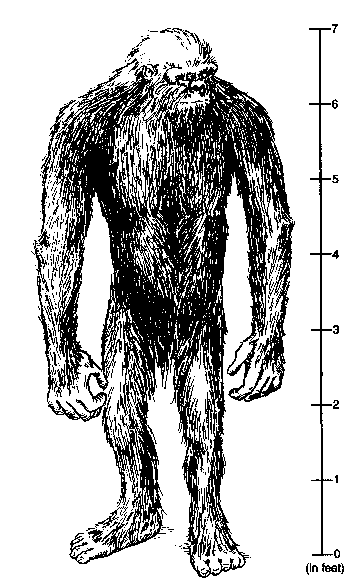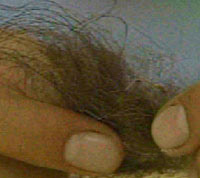
May 25, 2012
It was a huge week with hope anew that a serious DNA study might display good results in the forthcoming months for the quest for hairy hominoids.
However, with the good, there is always the bad, usually comments from people not connected to the discussed study, who have hardly researched the matter.

Eastern Canadian Sasquatch, as drawn by Harry Trumbore, for The Field Guide to Bigfoot and Other Mystery Primates.
One of the worst was a highlight in an article entitled, “Scientists on hunt for Bigfoot to test DNA in hair samples.”
In that news item, the media ended with the following, which they summarized in the subheadline, “Critic says ‘no serious scientist’ would undertake such research”:
David Frayer, a professor of biological anthropology at Kansas University, told The Associated Press in an email that “No serious scientist [would] treat Yeti as a worthy research project.”
He said previous tests on supposed Yeti hairs have already been done — “and they turned out to be from a bison.”

Frayer’s reference to the bison hair is about only ONE event, the Teslin hair sample found on a doorframe after a Sasquatch was seen in a yard on an Alberta native homestead, in 2005. (See here.) Personally, I consider this to have been an honest mistake after someone shook a buffalo rug, while cleaning their home. The hair sample is now housed in the International Cryptozoology Museum in Portland, Maine.
The best rebuttal directly to Frayer said it well here:
++++++
Resologist
2012/05/24
at 8:55 AM ET
Why does the Associated Press, (and CBC News which published this news article), find it necessary to include a criticism that “no serious scientist” would research the Yeti?
Professor Frayer should know this isn’t true.
Any physical anthropologist or zoologist should know about, (even if they haven’t bothered to read it), Ivan T. Sanderson’s book, Abominable Snowmen: Legend Come to Life.
Professor Frayer, himself, did comparative studies of ancient teeth, (American Journal of Physical Anthropology, 39: 413-426), and came to the conclusion that the Gigantopithecus, was more like humans than apes:
“Giganotpithecus blacki, on the other hand, can best be explained as an Asiatic hominoid (an aberrant hominid) which did not use tools, but rather continued to increase in body size as it adapted to the forest conditions. From the number of teeth found in China, it would seem that this specific adaptation (size vs tools) was quite adequate. Survival into the mid-Pleistocene attests to this… The late existence of these large primates proves their effective adaptation through size.”
If Homo erectus hunters did not kill off the Gigantopithecus, (reputed to stand 3 meters tall and weigh 540 kilograms), something might still be found in the mountainous forests that resembles the legendary Yeti and Sasquatch. One of the arguments that Gigantipithecus could not be a Yeti is its identification as an “ape” with a different gait than a “hominid”, (resembling Yeti and Sasquatch sightings), however Professor Frayer’s early research suggests that was wrong.
It’s okay to research ancient teeth and say that those species are extinct, but “no serious scientist” would bother to do an analysis of DNA samples to see if there might be unknown species to be discovered?
Read the book.
+++++++
Meanwhile, Jeff Meldrum has shared some insights, in the wake of the week’s big news:
On Saturday, April 28, [2012] I had lunch with Dr. Bryan Sykes and his lovely wife Ulla, in downtown Salt Lake City, Utah. Professor Sykes is the author of The Seven Daughters of Eve (2002), which traces the descent of Europeans back to seven women, who lived tens of thousands of years ago. His stop-off in Salt Lake City was part of a book tour for his latest popular title, DNA USA: A Genetic Biography of America. Sykes is a former Professor of Human Genetics at the University of Oxford and a current Fellow of Wolfson College. He is founder of Oxford Ancestors, a genealogical DNA testing firm.
Sykes published the first report on retrieving DNA from ancient bone in Nature, in 1989. He since has been involved in a number of high-profile cases dealing with ancient DNA, including those of Ötzi the Iceman, a natural mummy over 5,000 years old, discovered in the Alps between Austria and Italy, and the Cheddar Man, Britain’s oldest complete human skeleton, nearly 10,000 years old.
Sykes also analyzed hair samples from Bhutan attributed to the Yeti, which seemed to defy DNA identification. Interestingly, during our conversation I learned that further efforts were subsequently successful in determining that the hair originated from bear.
We also discussed the relict hominoid question and the potential for addressing the genetics of the issue. I was pleased to learn of his interest and intentions, first from RHI editorial board member Dr. Anna Nekaris, Reader in Biological Anthropology and Primate Conservation at Oxford Brooks University, who will be collaborating with Sykes on the production of a related television documentary project to include the results of the study. Nekaris’ field research into nocturnal prosimians of southern Asia has brought her into contact with local accounts of, e.g., the Orang Pendek and Mande Barung, two distinct potential relict hominoids. The “Oxford –Lausanne Collateral Hominid Project” is a welcome development.Jeff Meldrum
About Loren Coleman
Loren Coleman is one of the world’s leading cryptozoologists, some say “the” leading living cryptozoologist. Certainly, he is acknowledged as the current living American researcher and writer who has most popularized cryptozoology in the late 20th and early 21st centuries.
Starting his fieldwork and investigations in 1960, after traveling and trekking extensively in pursuit of cryptozoological mysteries, Coleman began writing to share his experiences in 1969. An honorary member of Ivan T. Sanderson’s Society for the Investigation of the Unexplained in the 1970s, Coleman has been bestowed with similar honorary memberships of the North Idaho College Cryptozoology Club in 1983, and in subsequent years, that of the British Columbia Scientific Cryptozoology Club, CryptoSafari International, and other international organizations. He was also a Life Member and Benefactor of the International Society of Cryptozoology (now-defunct).
Loren Coleman’s daily blog, as a member of the Cryptomundo Team, served as an ongoing avenue of communication for the ever-growing body of cryptozoo news from 2005 through 2013. He returned as an infrequent contributor beginning Halloween week of 2015.
Coleman is the founder in 2003, and current director of the International Cryptozoology Museum in Portland, Maine.
Filed under Abominable Snowman, Bigfoot, Breaking News, CryptoZoo News, Evidence, Forensic Science, Sasquatch